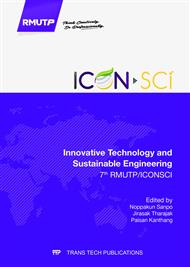p.73
p.77
p.81
p.85
p.88
p.92
p.99
p.104
p.108
The Study of Turbulent Nutrient Solution Flows in Difference Hydroponics System Arrangements
Abstract:
This work studied the turbulent flow of the nutrient solution which affected the growth of plants in four hydroponic systems; the horizontal (traditional), the vertical cup-grown, the ladder and the droplet systems, which were connected with individual solution pumps which submerged in only one nutrient solution tank to supply the turbulent nutrient solution flow to all systems. Two experiments were done by planting Red Oak lettuce, fluid and ambient temperatures, fluid pH and sunlight intensity were measured 2 times a day from 4 systems placed in the same area and environment during 20 days of the experimental periods. From both result sets, the lower ambient and solution temperatures in the 2nd experiment yielded more productivity. The results also showed that adjusting pipe and hose sizes did not cause the nutrient solution overflow out of the systems, the turbulent flow occurred and the horizontal system could produce the highest productivity. However, the higher pump power was required to produce the turbulent solution, the higher pump power higher heat transfer from the pump to the nutrient solution in the tank since all pumps were placed in the same solution tank, this heated solution caused the lower productivity in this work.
Info:
Periodical:
Pages:
88-91
Citation:
Online since:
June 2017
Authors:
Keywords:
Price:
Сopyright:
© 2017 Trans Tech Publications Ltd. All Rights Reserved
Share:
Citation:


